You are using an out of date browser. It may not display this or other websites correctly.
You should upgrade or use an alternative browser.
You should upgrade or use an alternative browser.
So this the one?!?! the 'elusive' Larger Florida mantis?
- Thread starter yen_saw
- Start date

Help Support Mantidforum:
This site may earn a commission from merchant affiliate
links, including eBay, Amazon, and others.
Ntsees
Well-known member
Errr...the resemblance is so close! I hate it when there's not enough information on the internet. Need more photo shots of both specimens at every angle/detail. Does it look like the Stagmomantis gracilipes is lacking the black speck on the forelegs (even then, that may not be a distinguishing mark and with the information on the internet, can we accept it as the Stagmomantis gracilipes)? The frustration I have when dealing with something like this. Oh well, by the end, this forum will make it clear.Shape is similar to this Stagmomantis: http://bugsincyberspace.com/stagmomantis_gracilipes.html
Last edited by a moderator:
Ntsees
Well-known member
Yes, I understand that they are both different species. What I was trying to get at was that it's difficult to distinguish them with the limited information that's available. The mantid in the link posted by Peter and the mantid on this topic could even be the same species, but if they are not, what is it that distinguishes them? Information the on the internet is not always valid. I just hope the mantid that Yen Saw found is indeed a floridensis so that this will be put to rest.Those two are different species. Please don't cause more confusion as there already is.
Last edited by a moderator:
Barring some accidental importation, S. gracilipsis can only be found in AZ. Location alone makes the odds very low of S. gracilipsis being what Yen found. I will try to find a good species description to scan and post.

$13.53
Butterfly Breeding Net, Folding Butterfly Habitat Cage White Butterfly Mesh Cage for Kid Garden Science Education Tool 40x40x60cm
enshishiqiannanwangluoyouxiangongsi

$34.99
$39.99
RESTCLOUD 30" Large Monarch Butterfly Habitat Cage, Outdoor Insect Mesh Cage Terrarium 16.5" x 16.5" x 30"
Restcloud

$13.19 ($13.19 / Count)
Butterfly Breeding Net Folding Butterfly Habitat Cage White Butterfly Mesh Cage for Kid Garden Science Education Tool 40x40x60cm Butterfly Cage
Hubeichunliangnongyefazhanyouxiangongsi

$13.99 ($0.44 / Ounce)
Fresh Fruit Fly Culture (Drosophila Hydei) - Praying Mantis Mantid Frog Lizard Food - 32oz Cup
Surmen Legacy

$18.50
Praying Mantis Egg Case With Hatching Habitat Cup- 2 Praying Mantids Egg Cases
NaturesGoodGuys

$39.95 ($1.25 / Ounce)
Creation Cultivated 32oz Fruit Fly Culture - Live Feeder Insects for Praying Mantis, Jumping Spiders, Geckos, Lizards, Dart Frogs (Drosophila Hydei Flightless)
Creation Cultivated

$13.99 ($223.84 / lb)
Surmen Legacy Freshly Started Wingless Drosophila Melanogaster Fruit Fly Culture
Surmen Legacy

$3.19 ($42.53 / lb)
$6.09 ($81.20 / lb)
Fluker's Gourmet Canned Food for Reptiles, Fish, Birds and Small Animals, Black, Mealworms 1.23 Ounce (Pack of 1)
Amazon.com

$11.74 ($0.02 / Count)
Predator Foods Bulk Live Mealworms - 500 Count (Medium - 0.5")
Predator Foods

$20.99 ($20.99 / Count)
Jumping Spider Enclosure (4.7"x3.9"x7.8"), Spider Terrarium, Praying Mantis Habitat, Suitable for Small Arboreal Reptiles, Mantises, Spiders, and Other Invertebrates
Jiara Electronics

$16.99 ($16.99 / Count)
Josh's Frogs Freshly Started Flightless Drosophila Hydei Fruit Fly Culture
Josh's Frogs

$18.99 ($2.12 / Ounce)
Josh's Frogs Producing Wingless Drosophila Melanogaster Fruit Fly Culture
Josh's Frogs
PhilinYuma
Well-known member
Yeah. The Terra Typica site seems to be gone for ever, and the Tree of Life and similar sites don't provide us with those essential dichotomous keys. Many of the American members on this forum are particularly interested in those members of the Stagmomantis genus that inhabit our Southern States and I think that all three American moderators have collected them in the field . A number of us have contacts with entomologists, but you could elevate your status from Valued Member to Forum Treasure by providing us with a (simplified if necessary) key to the Stagmomantis genus. I know of five extant members in the U.S. and have heard from a reliable source (thanx Yen!) that there may be seven. There are a number of us who can use a binocular microscope or powerful simple lens, and can maneuver our way through a dichotomous key. Thanks! We shall be forever in your debt and wiill obviously have specimens to send you as an expression of our gratitude!To make things clear, the internet is absolutely no source of any taxonomic relevance whatsoever.
Massaman: "Just the luck of the draw to have found this hard to find species!"
Either that or the work of a skilled and experienced mantis hunter, or both!
http://mantidforum.net/forums/index.php?ac...post&id=160
http://mantidforum.net/forums/index.php?ac...post&id=161
This is part of a key I've posted awhile ago. It should help with "most" Stegmomantids. I have no info on S. montana though!!
http://mantidforum.net/forums/index.php?ac...post&id=161
This is part of a key I've posted awhile ago. It should help with "most" Stegmomantids. I have no info on S. montana though!!
Last edited by a moderator:
PhilinYuma
Well-known member
LOL, Mike! Is that from the Helfer book? I'm sure that I have it floating around somewhere! Trouble is that it may be too old to be of any taxonomic use whatever.http://mantidforum.net/forums/index.php?ac...post&id=160http://mantidforum.net/forums/index.php?ac...post&id=161
This is part of a key I've posted awhile ago. It should help with "most" Stegmomantids. I have no info on S. montana though!!
There is no key. This genus is in a horrible state, with about 20 species. In the US, there should be the following ones:
carolina (Johansson, 1763): southern States
californica Rehn & Hebard, 1909: California
floridensis Davis, 1919: Florida
gracilipes Rehn, 1907: Arizona (Pima County)
limbata (Hahn, 1835): Arizona, Texas -> may be a complex of two species
montana Saussure & Zehntner, 1894: occurrence in the US doubtful
carolina (Johansson, 1763): southern States
californica Rehn & Hebard, 1909: California
floridensis Davis, 1919: Florida
gracilipes Rehn, 1907: Arizona (Pima County)
limbata (Hahn, 1835): Arizona, Texas -> may be a complex of two species
montana Saussure & Zehntner, 1894: occurrence in the US doubtful
S. carolina is found in northern states too and has a very large range.There is no key. This genus is in a horrible state, with about 20 species. In the US, there should be the following ones:carolina (Johansson, 1763): southern States
californica Rehn & Hebard, 1909: California
floridensis Davis, 1919: Florida
gracilipes Rehn, 1907: Arizona (Pima County)
limbata (Hahn, 1835): Arizona, Texas -> may be a complex of two species
montana Saussure & Zehntner, 1894: occurrence in the US doubtful
I think the locations Christian gave are for where the species may have been first found and described. S. carolina, S. limbata and S. californica all have HUGE ranges across multiple states.
For mantids that key is still valid. None of the US species have had name changes, nor can I find information on any new species that have been found. There are several Stegmomantis species found in Northern Mexico that could potentially show up at the border though. Do they get driver's licences? I assume that S. montana fits in the last catagory.
For mantids that key is still valid. None of the US species have had name changes, nor can I find information on any new species that have been found. There are several Stegmomantis species found in Northern Mexico that could potentially show up at the border though. Do they get driver's licences? I assume that S. montana fits in the last catagory.
Last edited by a moderator:
PhilinYuma
Well-known member
+1I think the locations Christian gave are for where the species may have been first found and described. S. carolina, S. limbata and S. californica all have HUGE ranges across multiple states.For mantids that key is still valid. None of the US species have had name changes, nor can I find information on any new species that have been found. There are several Stegmomantis species found in Northern Mexico that could potentially show up at the border though. Do they get driver's licences? I assume that S. montana fits in the last catagory.
When first named, Stagmomantis limbata did not occur west of AZ and is now one of the most common mantids in CA.
Unlike some states (e.g.Alaska, Connecticut, Idaho, Louisiana, Montana, Nevada, New Mexico, North Carolina, Ohio, Rhode Island, Tennessee, Utah, Washington and West Virginia
kamakiri
Well-known member
Great work Yen! I'm very interested in buying some for breeding...
cloud jaguar
Well-known member
+1 ! Put me on the list Yen 
That key may work for 5 US species, but, as I ommitted some species which were also occasionally listed but not found since. This is probably just due to some mis-IDs, but you never know. And, limbata may actually comprise two species, but this is an old information which was not reprised since. Not talking about the mesoamerican species. Formerly, there were about 5 genera where today is only one. All in all a completely messed up group.
Both David (Yager) and Texas A&M curator couldn't think of anything else beside Stagmomantis floridensis based on the available information (http://entnemdept.ifas.ufl.edu/choate/mantid_key2_03.pdf) but refer me to the science museum in Gainesville, FL (http://www.fsca-dpi.org/OverViewFrame.htm) which carried dried specimen of S. floridensis. After contacting the head of curator there, he is very certain it is S. floridensis from the pics I sent and the similarity from the specimen in museum collection, and said a dried specimen wouldn't be necessary. Another entomology professor from U of F mentioned S. carolina is more common than S. floridensis although the later species is visibly larger, and there is no record of S. gracilipes in FL.
So I guess it is the Larger Florida mantis, Stagmomantis floridensis!!
Here is a pic of three adult male Stagmomantis sp.
THe far left is MO 'Carolina', the middle is TX 'Carolina' and the one on right is Larger Florida. The Texas Carolina looks like the hybrid between the two Sorry I didn't say that.
Sorry I didn't say that.
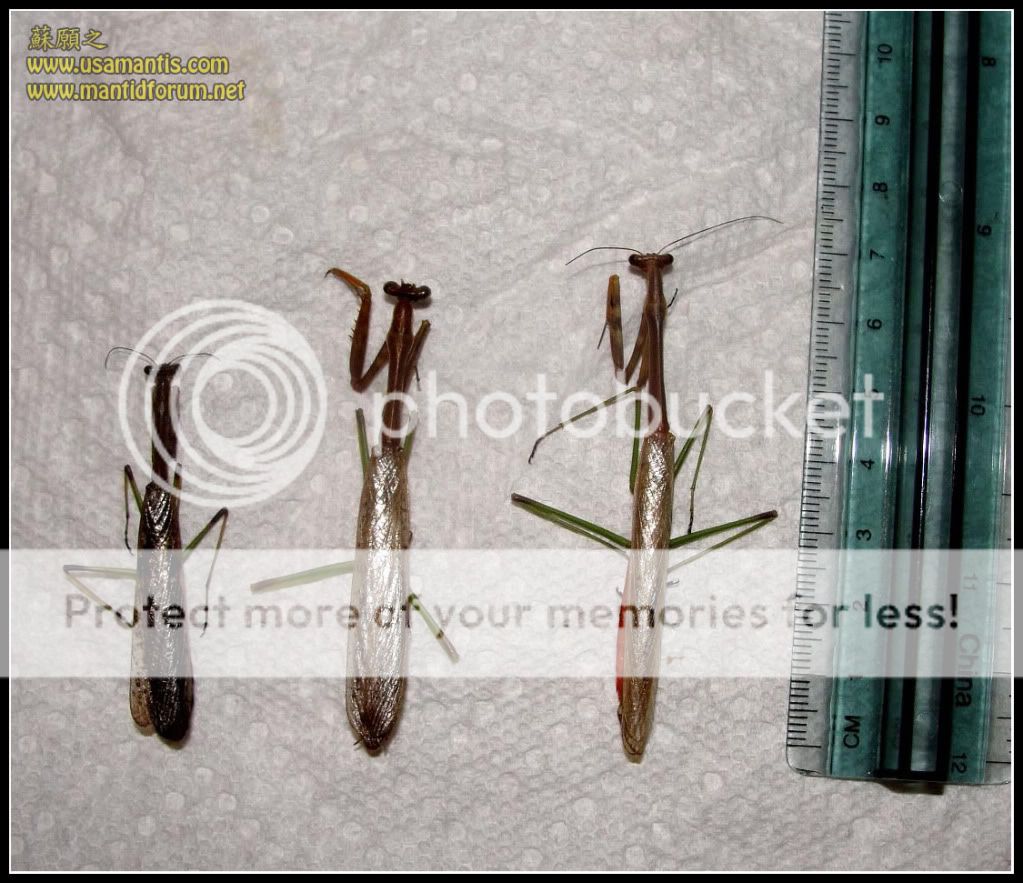
Just one of the comparison between the two species, adult male.
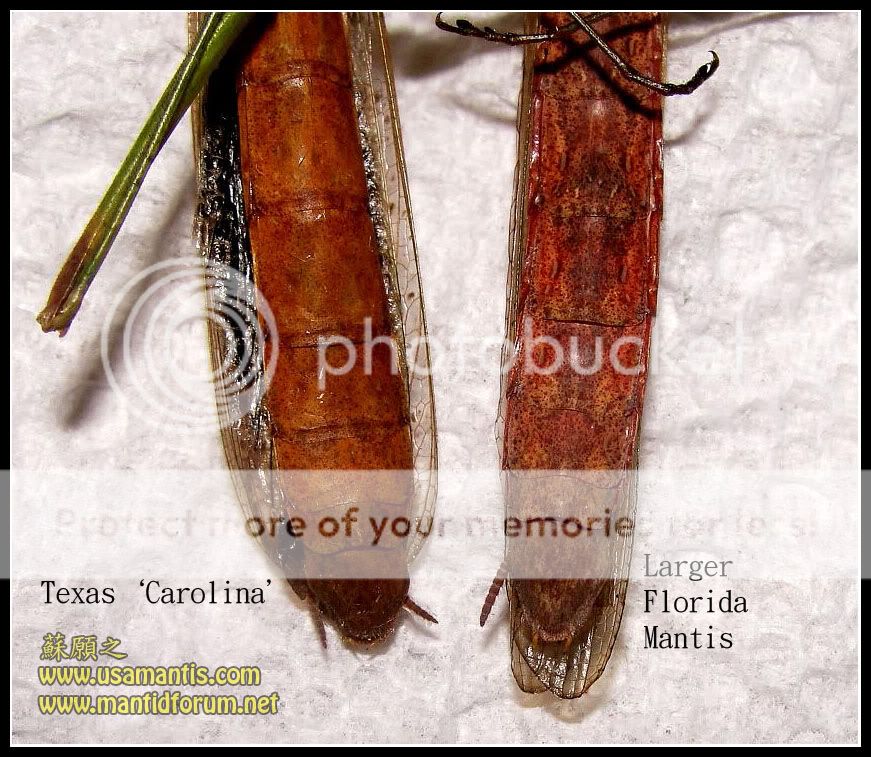
My son took this while I was checking out the details between some dead Stagmomantis sp. and about to spread the dead ones
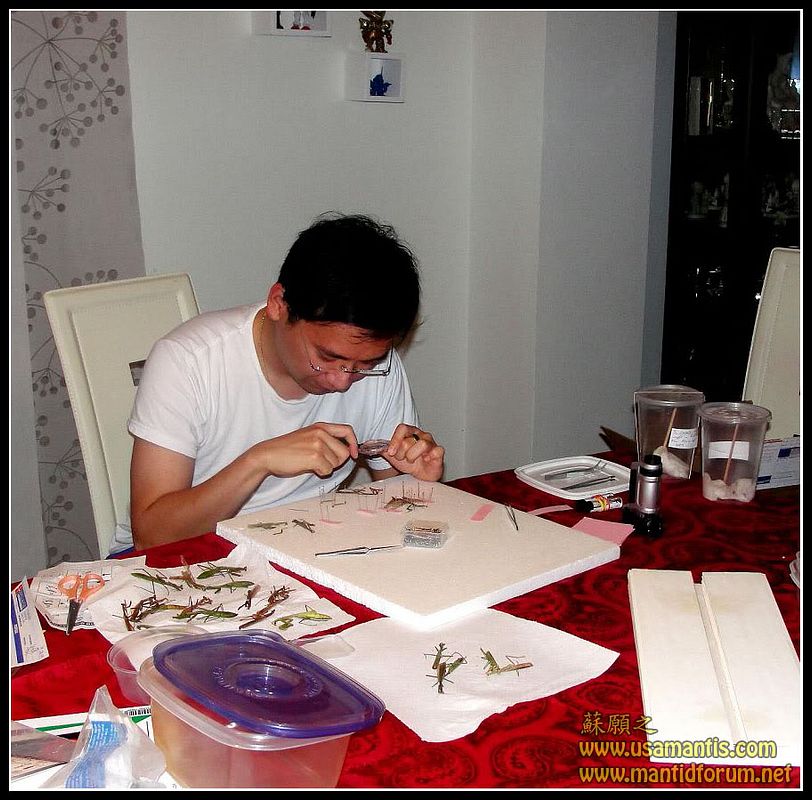
Took over the camera. This is adult male 'Carolina' from Texas

Three of the pinned up Stagmomantis
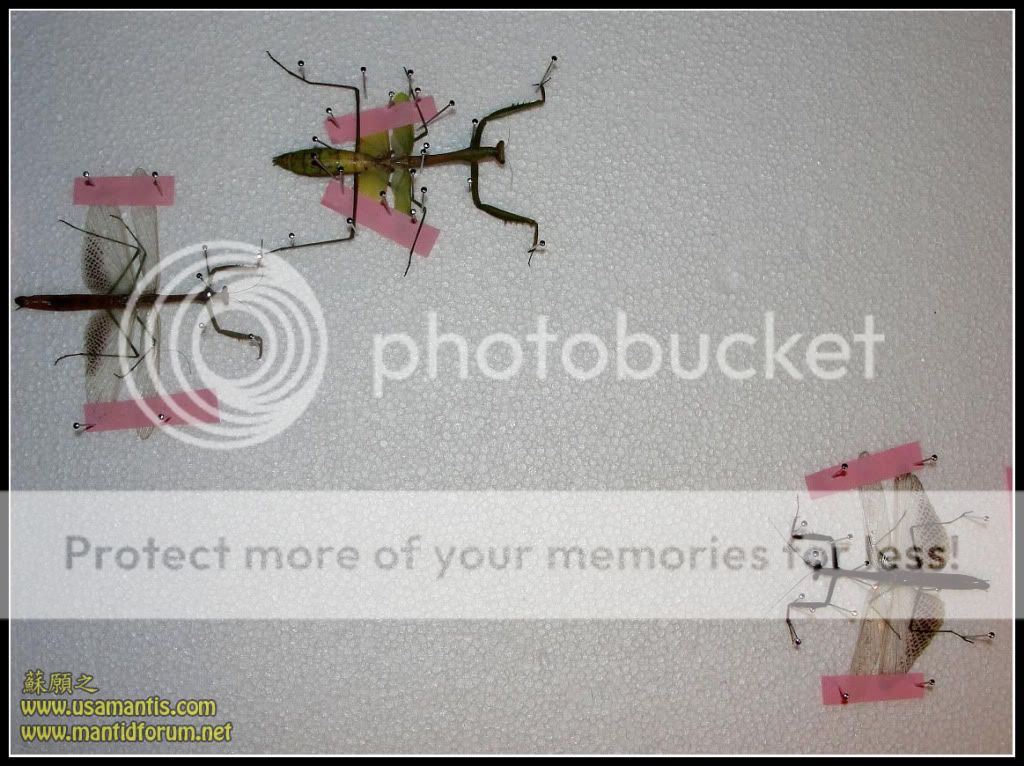
S. floridensis pair
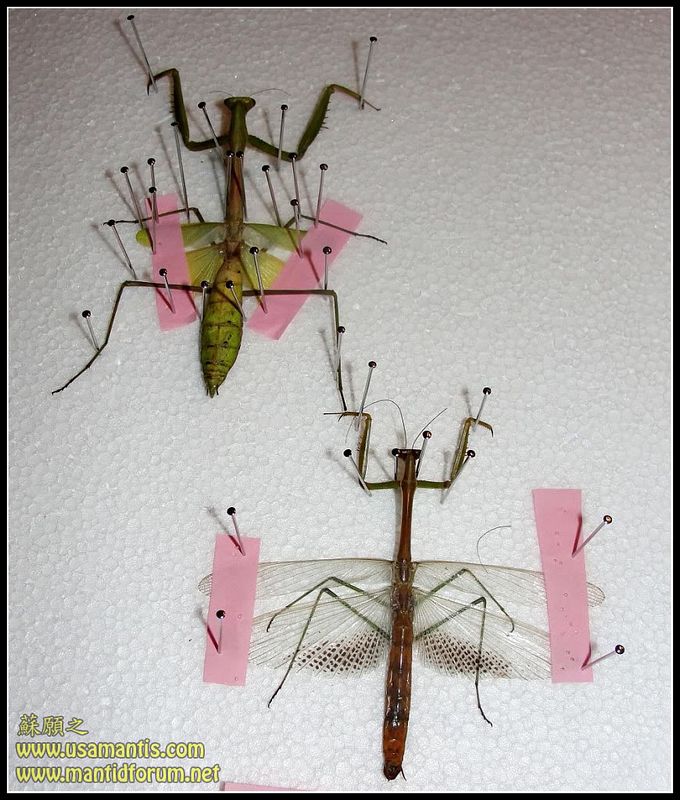
I am trying to document my finding between the species hopefully it could be any help for the future reference.
So I guess it is the Larger Florida mantis, Stagmomantis floridensis!!
Here is a pic of three adult male Stagmomantis sp.
THe far left is MO 'Carolina', the middle is TX 'Carolina' and the one on right is Larger Florida. The Texas Carolina looks like the hybrid between the two

Just one of the comparison between the two species, adult male.

My son took this while I was checking out the details between some dead Stagmomantis sp. and about to spread the dead ones

Took over the camera. This is adult male 'Carolina' from Texas

Three of the pinned up Stagmomantis

S. floridensis pair

I am trying to document my finding between the species hopefully it could be any help for the future reference.
Thanks Orin.Your abilities to locate interesting mantids are impressive. Great find on the S. floridensis Yen.
Yes i still have plenty. Yeah that would be great lets aim for next Summer or Fall.Very nice. Any of them still alive? Can't wait until we can collect together. We both have the "eye".































